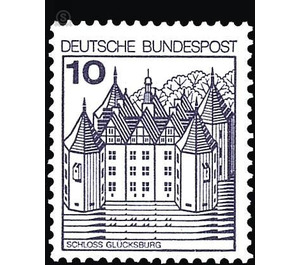Postage stamp: castles and palaces - Germany / Federal Republic of Germany 1977 - 10 Pfennig
Theme: Architecture
| Country | Germany / Federal Republic of Germany |
| Issue Date | 1977 |
| Face Value | 10.00 |
| Color | blue |
| Perforation | K 14 |
| Printing Type | Lithography |
| Stamp Type | Postage stamp |
| Item Type | Stamp |
| Chronological Issue Number | 802 |
| Chronological Chapter | GER-BRD |
| SID | 952069 |
| In 152 Wishlists | |
A new series of permanent rolling press with depictions of German castles and palaces replaces the roller-type brand series "Accident Prevention". The postage stamps of 10 and 30 Pfennig appearing as additional values in this series with the inscription Deutsche Bundespost are published at the same time and in the same motif as the inscription Deutsche Bundespost Berlin; two values have already been issued on January 13 and February 16, 1977. The simple but impressive Wasserschloss Glücksburg is one of the major works of the Renaissance in Schleswig-Holstein. In 1210, Cistercians from Guldholm founded the Rüdekloster, King Christian III. of Denmark 1538 reversed. In 1582, Duke Johann of Schleswig-Holstein-Sonderburg d. J. the property. He had the monastic buildings broken off and from their material in their vicinity built in the following years by the architect of Flensburg Nikolaus Karies the great castle. The terrain around the castle was dammed to a pond. The Duke's motto "God give happiness with peace" led to the name "Glücksburg." His son Philipp (1584-1663) made Glücksburg a residence. From 1854 to 1863, the castle served after the unfavorable for the Duchies of Schleswig and Holstein War of 1848/51 as the seat of government of King Frederic VII of Denmark, who died on November 15, 1863 Glücksburg. In 1864, the ducal family got the castle back and still owns it today. The castle is a building block of three gabled houses next to each other and four mighty octagonal corner towers. The chapel dates from the construction of the castle, its present design from 1717. The orangery from 1743 was built in 1827 according to plans by W. F. Meyer in classicist style. (Text: excerpts from the texts of the German Castle Association e.V. Braubach - Dr. W. Avenarius)


